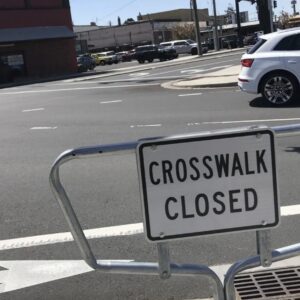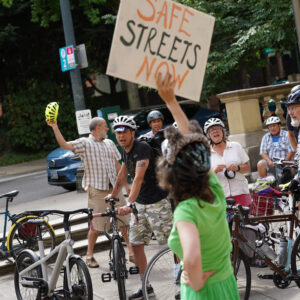
Manager Troy Costales.
Troy Costales is the Traffic Safety Division Manager for the Oregon Department of Transportation (ODOT). In that position, he oversees about $28 million per year in a variety of programs to decrease the amount of fatal and injury crashes on Oregon roads. Costales was also on the committee put together by the Transportation Research Board to find out why the United States continues to lag behind other countries when it comes to saving lives. The TRB issued a report on their findings last week.
With recent national attention on road safety and with last week’s launch of a new safety campaign for high-speed roads (many of them under the jurisdiction of ODOT), I’ve been taking a closer look at ODOT’s traffic safety efforts. As part of my research, I did a phone interview with Costales last Thursday. Read parts of that conversation below…
You were on the TRB committee. Were you surprised by the findings?
“No. I wasn’t surprised for a few reasons. They were comparing individual European countries against the block of the United States. If you were to say, take Sweden and Germany, and then compare them individually with Oregon Massachusetts, or Minnesota, you’d have individual states that rank favorably — if not better than — those countries. I’m also not surprised at what we learned because I was also part of a group back in 2002-3 that visited some of those countries on behalf of the US DOT to learn about what they were doing from a management point of view.”
What do you mean by “management” when it comes to traffic safety?
“Management is saying that you’re not chasing themes for the day, but you are doing some things that are systemic, that are system-based improvements. For example, in Oregon the DMV says you have the chance to appeal your license suspension after being charged with DUI. When we track the system, we find people who were routinely appealing and we noticed that the suspension wasn’t being upheld. Why not? Because the officers weren’t showing up. When the officers don’t show up, the person doesn’t lose their license. We realized we needed to take a systemic look at that situation and figure out what was going on.
Another example of management is safety grants. If I’m going to spend $1 million for special DUI enforcement, here in Oregon officers can’t work on them unless they’ve had a refresher course within the last three years. Since I’m putting taxpayer dollars to work, I want people doing the job that know how to do it. In other states, that doesn’t always happen.”
Are there plans in the upcoming legislation session to make changes to laws that impact traffic safety?
“In Oregon, driver’s ed for new teen drivers is voluntary*; two of five teens take a formal driver’s ed program. One thing we are proposing is that we look at some sort of phased-in move toward mandatory driver’s ed for teens. Stats show that kids who take driver’s ed get fewer citations, license suspensions, and are involved in fewer crashes. I’d rather have people understanding their responsibilities around driving when they’re 15-16 than try to teach them when they’re older and they’ve already their own habits and beliefs. We’d start a pilot program in Portland/Tri-County area because that’s where you have most driver’s ed vendors. The legislature would have to approve of it, and with the economy the way it is… [courses can cost between $175 and $300]… With fewer crashes all around, we feel that mandatory driver’s ed for teens would pay itself back within the first two years of driving.”
[*More on Oregon’s Teen Driver Training program here.]
Oregon’s fatal and injury crashes are going down. What do you think accounts for that?
“The safety belt law. We are the only state in the country where citizens themselves voted for the safety belt law. It applies to all seating positions and all ages and it’s a primary offense [meaning police can pull people over for that offense alone]. Safety belts mixed in with the technology of today’s cars is giving you the greatest chance of survivability you’re going to have. By the same token, our motorcycle helmet law (also passed by citizens) has been 30-35% effective in reducing death and injury. Also, since our Oregon-ized version of the Graduated Driver’s License program has gone into effect, the number of teens involved in fatal and injury crashes dropped 56%. Our program in Oregon is creating better drivers.”
Since the crash rates goes down as the amount of driving goes down; why not encourage less driving?
“We do. I will tell you when you have more people in a vehicle, the driver tends to be safer, so we promote carpooling. We also collaborate across programs here at ODOT. Julie Yip [Safe Routes to School program manager] is in my office. My department also plugs into OBPAC [Oregon Bicycle and Pedestrian Advisory Committee] at different times. Cross-program linkages is something that European countries do without thinking about it. Too often people are not communicating… I’m not saying Oregon has it fixed, but there are spots of cooperative work and cross-platform communication. We also sponsor the Drive Less, Save More program.”
What’s the biggest problem you face in tackling safety?
“One of them is our very weak basic speed law. In Oregon there are two distinct pieces of our speed law: Speed limit and basic rule. Speed limit is in effect on Interstates and inside city limits. So, if it says 45, and you are doing 46, you can get a ticket. But, let’s say you’re heading from Portland to Bend… once you peel off I-84 to Bend — let’s say on Highway 97 — it becomes basic rule unless you’re inside a city. Under the basic rule speed law, if it’s 55 and you do 56 you can technically still get a ticket but you can argue to a judge that 56 was safe and prudent and then explain the reasons why.
This means we have the most discretionary speed law on our roads that have the worst safety record. [The majority of fatal and serious injury crashes in Oregon happen on rural roads. In 2008, 51% of all traffic fatalities in Oregon involved speeding.] Having the basic rule law out there on rural roads just basically breeds contempt. When it’s a subjective situation it gives road users a mixed message.”
The amount of people who died while walking on Oregon roads so far this year is way up over last year. How do you respond that? (This response came via email.)
“Any pedestrian killed is one too many. However, the context is that we are at a pretty average number:
- 2000 – 2004 avg: 51
- 2005: 49
- 2006: 48
- 2007: 50
- 2008: 53
- 2009: 37 (lowest since early 1940’s)
- 2010: 56 (through 11/17/10)
The highest numbers were 139 (in 1940), 130 (1946), and a more recent 102 (1972). In the last twenty years the number has generally been between 45 and 68.
A lot of the 2010 comparison numbers have been against last years final tally (2009), which was good news that it was so low.
Many of the pedestrian fatalities relate to the pedestrian not being visible and taking action that drivers are not expecting (crossing mid block or in the roadway where a pedestrian shouldn’t be). We also have some pedestrians that have been hit by impaired drivers, even on the opposite side of the roadway (Lancaster Drive in Salem).
The number (and yes I know each one of the numbers is a person, has a family, friends, community) is one of the highest in a decade that is why we have asked for the media to repeat the message about being visible and following the rules. This increases your safety more than anything else.”
I hope this gives you a better sense of ODOT’s top traffic safety staffer. I’ve got more on ODOT’s role in traffic safety — including what they’re doing or not doing about speed — that I plan to share in the coming days and weeks. Stay tuned.






Thanks for reading.
BikePortland has served this community with independent community journalism since 2005. We rely on subscriptions from readers like you to survive. Your financial support is vital in keeping this valuable resource alive and well.
Please subscribe today to strengthen and expand our work.
Now it appears that ODOT’s official position on pedestrian deaths is Blame the Victim.
Further, while he does address speeding as a problem, and how easy it is to avoid prosecution if one illegally speeds, he says nothing about legal speeding. ALL of ODOT-controlled roadways in Portland allow for unsafe speeds by motor vehicles!
Jonathan and Troy…thanks for the discussion, as I learned a few new things about OR traffic law…being up here in VAN WA.
Jonathan, thank you for the insightful interview. I like Troy’s idea of more access to Driver Ed for young drivers. I also believe Troy is correct that speeding is a safety issue. Slower traffic makes safer roads, especially for cyclists and pedestrians.
Another safety issue that I think is worth mentioning is vehicle height. Many suv’s & 4×4’s sit high enough off the road to cause a number of issues. Bumper height over rides other vehicles, bypassing the protection to that vehicle’s occupants and potentially causing the suv to rollover. Decreases vehicle handling, and increases braking distance. Reduced visibility for following vehicles prevents the following vehicle from seeing cyclists up ahead. They also have larger blind-spots, and are less likely to see cyclists, when turning or backing up. A minimum bumper height would be an excellent step forward in safety.
Very well said, “Word up”
I heard that Troy’s response to the pedestrian question was actually “I don’t really care about that. Can I have an intern send you an email later?”
mandatory drivers ed for teens is bad… I don’t want the state forcing my kid to drive against his will… now if they want to make it a requirement of getting a driver’s license that’s a great idea…
seat belt and helmet laws suck… let people make their own decisions… seat belts have been around forever and crash rates continue to go up… make crashes less frequent, not safer… crashes are safe so people don’t try to avoid them as much…
talking about teen safety and then saying a car full of teens is safer than a lone teen? I would disagree since that’s a ton of distraction for a new driver… for any driver really…
speeding does not cause wrecks… failure to control your vehicle causes wrecks… and if those lazy cops would get off their asses and bust people for real violations that effect safety rather than sitting on the side of the road waiting for a speeder then the roads would be a better place…
good to see the pedestrian death rate is average and was only a lot compared to a super low last year…
overall I don’t like this guy’s message at all… he’s the typical weak politician that doesn’t want to address the real problems because it would be unpopular…
Mandatory driver education for teens means just that. It does not force teens to drive, but for those teens that choose to drive, they will have to take an approved driver education course.
Oregon’s reductions in crashes and suspensions and convictions for teen drivers is among the most aggressive in the country, and part of that credit is due to the driver education standards that Oregon has adopted and promotes continually.
When you hear that every crash costs the state 100,000.00 on average it is also a financial benefit. As you know, WE are the state, all of us; we all pay when people have crashes. So driver education not only saves lives, but saves money in the long term.
This idea that pedestrians need to be visible is dangerously beginning to sound like scripture. Every man, woman and child within modern civilization is, at some point in their day, a pedestrian. We’re not going to reform our entire society to wear blinking lights and construction worker vests every time we step out into the world for the benefit of car culture.
If you can’t see an object in the road the size of a child or larger, you shouldn’t be on the road. End of story.
I agree that pedestrian visibility is creeping into the discussion of motor vehicle collisions with pedestrians in a bad way.
It’s time to realize that drivers drive with impaired visibility – always – and frame the discussion in those terms.
It would help to recognize that as a driver, you simply can’t see very well, don’t pretend that you can and then blame others for not being more visible.
Parts of the car itself are in the way, passengers are in the way, the dog and the kids and the groceries are in the way.
For that classic case: dark and raining, glare of oncoming headlights and reflections from the street there’s a fundamental truth: driver’s can not see very well. Let’s not divert the responsibility for impaired visibility to the objects that the drivers can’t see.
The solution to this problem is not to make everything in the world visible to drivers even under adverse conditions. That’s just not possible, practical, or perhaps even desireable.
The solution is not to paint every tree, rock, deer and person with reflective coatings.
One simple solution to improve driver’s impaired ability to see is for them to slow down.
Maybe that means lower night time speed limits, or lower speed limits when it’s raining and dark. Oh wait, the basic speed law already covers that.
Let’s try some more enforcement of the basic speed law. It’s not really operating a motor vehicle in a manner that is safe for conditions if collisions are occurring in the process.
What does it take to make a stronger basic speed rule?
Yeah, blaming the whatever gets hit by the car for not being visible enough is ridiculous.
If you are going to fast to stop before you hit something, then you are GOING TOO FAST.
Tinkering with speed limits is fine, but won’t change driving speeds unless limits are enforced, and speeding is dis-incentivized.
Speeding and red light running are sociopathic behaviors, that lots of people engage in daily. If they learned to associate it with something unpleasant maybe they might stop.
At least the Mayor said that one of the goals of the new “See Kids” banners is to get people to slow down. Saying it is the easy part.
I have recently seen a driver hit a pedestrian and had to avoid drivers who would have hit me on more than one occasion. I could see the drivers, so I know they could see me. I could also see that the drivers were not looking. Drivers hit pedestrians because they are not looking – not because the pedestrain is not visible. The invisible man is science fiction.
“If you are going to fast to stop before you hit something, then you are GOING TOO FAST.”